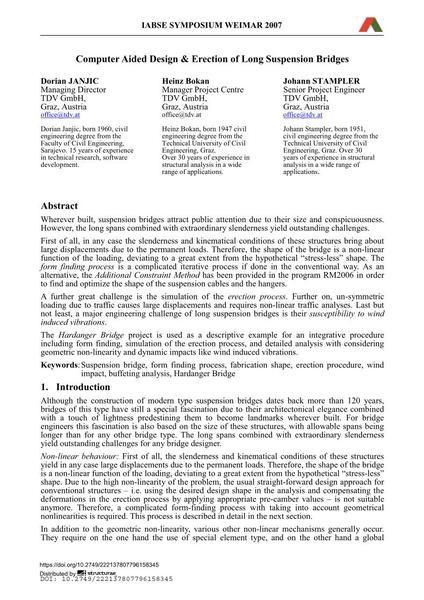Computer Aided Design & Erection of Long Suspension Bridges

|
|
|||||||||||
Bibliographic Details
| Author(s): |
Dorian Janjic
Heinz Bokan Johann Stampler |
||||
|---|---|---|---|---|---|
| Medium: | conference paper | ||||
| Language(s): | English | ||||
| Conference: | IABSE Symposium: Improving Infrastructure Worldwide, Weimar, Germany, 19-21 September 2007 | ||||
| Published in: | IABSE Symposium Weimar 2007 | ||||
|
|||||
| Page(s): | 386-389 | ||||
| Total no. of pages: | 8 | ||||
| Year: | 2007 | ||||
| DOI: | 10.2749/222137807796158345 | ||||
| Abstract: |
Wherever built, suspension bridges attract public attention due to their size and conspicuousness. However, the long spans combined with extraordinary slenderness yield outstanding challenges. First of all, in any case the slenderness and kinematical conditions of these structures bring about large displacements due to the permanent loads. Therefore, the shape of the bridge is a non-linear function of the loading, deviating to a great extent from the hypothetical stress-less shape. The form finding process is a complicated iterative process if done in the conventional way. As an alternative, the Additional Constraint Method has been provided in the program RM2006 in order to find and optimize the shape of the suspension cables and the hangers. A further great challenge is the simulation of the erection process. Further on, un-symmetric loading due to traffic causes large displacements and requires non-linear traffic analyses. Last but not least, a major engineering challenge of long suspension bridges is their susceptibility to wind induced vibrations. The Hardanger Bridge project is used as a descriptive example for an integrative procedure including form finding, simulation of the erection process, and detailed analysis with considering geometric non-linearity and dynamic impacts like wind induced vibrations. |
||||
| Keywords: |
suspension bridge Erection procedure form finding process fabrication shape wind impact buffeting analysis Hardanger Bridge
|
||||

